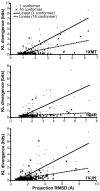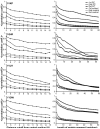Ensemble refinement of protein crystal structures: validation and application
- PMID: 17850744
- PMCID: PMC2039884
- DOI: 10.1016/j.str.2007.06.019
Ensemble refinement of protein crystal structures: validation and application
Abstract
X-ray crystallography typically uses a single set of coordinates and B factors to describe macromolecular conformations. Refinement of multiple copies of the entire structure has been previously used in specific cases as an alternative means of representing structural flexibility. Here, we systematically validate this method by using simulated diffraction data, and we find that ensemble refinement produces better representations of the distributions of atomic positions in the simulated structures than single-conformer refinements. Comparison of principal components calculated from the refined ensembles and simulations shows that concerted motions are captured locally, but that correlations dissipate over long distances. Ensemble refinement is also used on 50 experimental structures of varying resolution and leads to decreases in R(free) values, implying that improvements in the representation of flexibility observed for the simulated structures may apply to real structures. These gains are essentially independent of resolution or data-to-parameter ratio, suggesting that even structures at moderate resolution can benefit from ensemble refinement.
Figures








References
-
- Austin RH, Beeson KW, Eisenstein L, Frauenfelder H, Gunsalus IC. Dynamics of ligand binding to myoglobin. Biochemistry. 1975;14:5355–5373. - PubMed
-
- Brunger AT, Adams PD, Clore GM, DeLano WL, Gros P, Grosse-Kunstleve RW, Jiang JS, Kuszewski J, Nilges M, Pannu NS, et al. Crystallography & NMR system: A new software suite for macromolecular structure determination. Acta Crystallogr D Biol Crystallogr. 1998;54:905–921. - PubMed
-
- Burling FT, Brunger AT. Thermal Motion and Conformational Disorder in Protein Crystal-Structures - Comparison of Multi-Conformer and Time-Averaging Models. Israel Journal of Chemistry. 1994;34:165–175.
Publication types
MeSH terms
Substances
Grants and funding
LinkOut - more resources
Full Text Sources
Molecular Biology Databases

